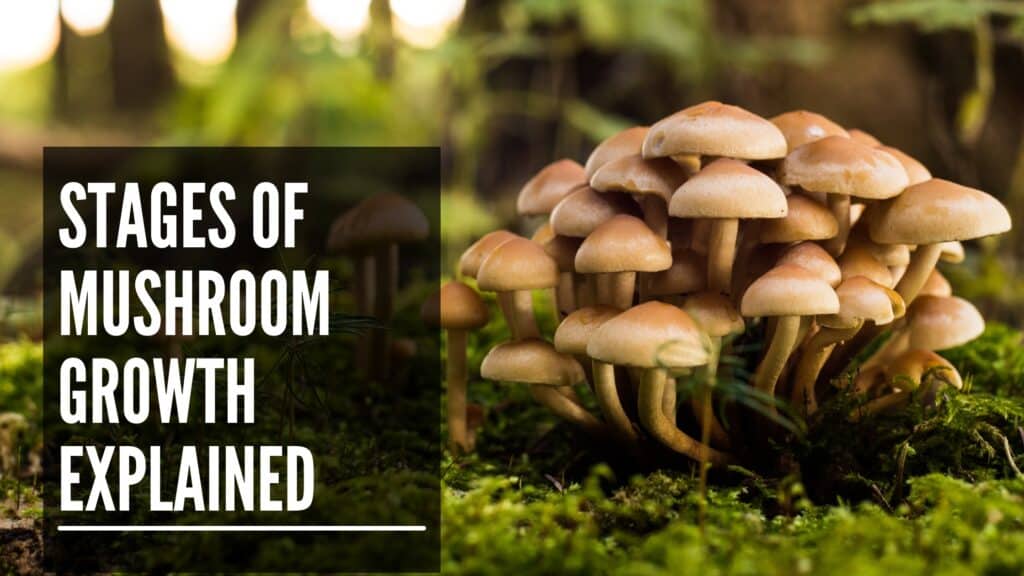Mushrooms have always captivated our interest, not just for their culinary uses but also for their vital role in nature and human health. These fascinating organisms undergo a complex and intriguing growth cycle, each stage playing a crucial part in their development and benefits. Whether you’re a mushroom enthusiast, a home cultivator, or someone curious about the science behind mushrooms, understanding their growth stages can provide valuable insights.
The stages of mushroom growth—from the initial spore germination to the final release of spores—highlight the remarkable journey these fungi undertake. By delving into each stage, we can appreciate how mushrooms grow, thrive, and contribute to our ecosystems and health. This article will explore each phase of the mushroom life cycle in detail, providing a comprehensive guide to understanding these incredible organisms.
Quick Summary
- Spore Germination: Initiation phase where spores develop into mycelium.
- Mycelium Development: Mycelium spreads and establishes a network.
- Primordia Formation: Transition phase where tiny mushroom structures form.
- Fruiting Body Development: Full development of the mushroom body.
- Maturation and Spore Release: Mature mushrooms release spores for reproduction.
Stage 1: Spore Germination
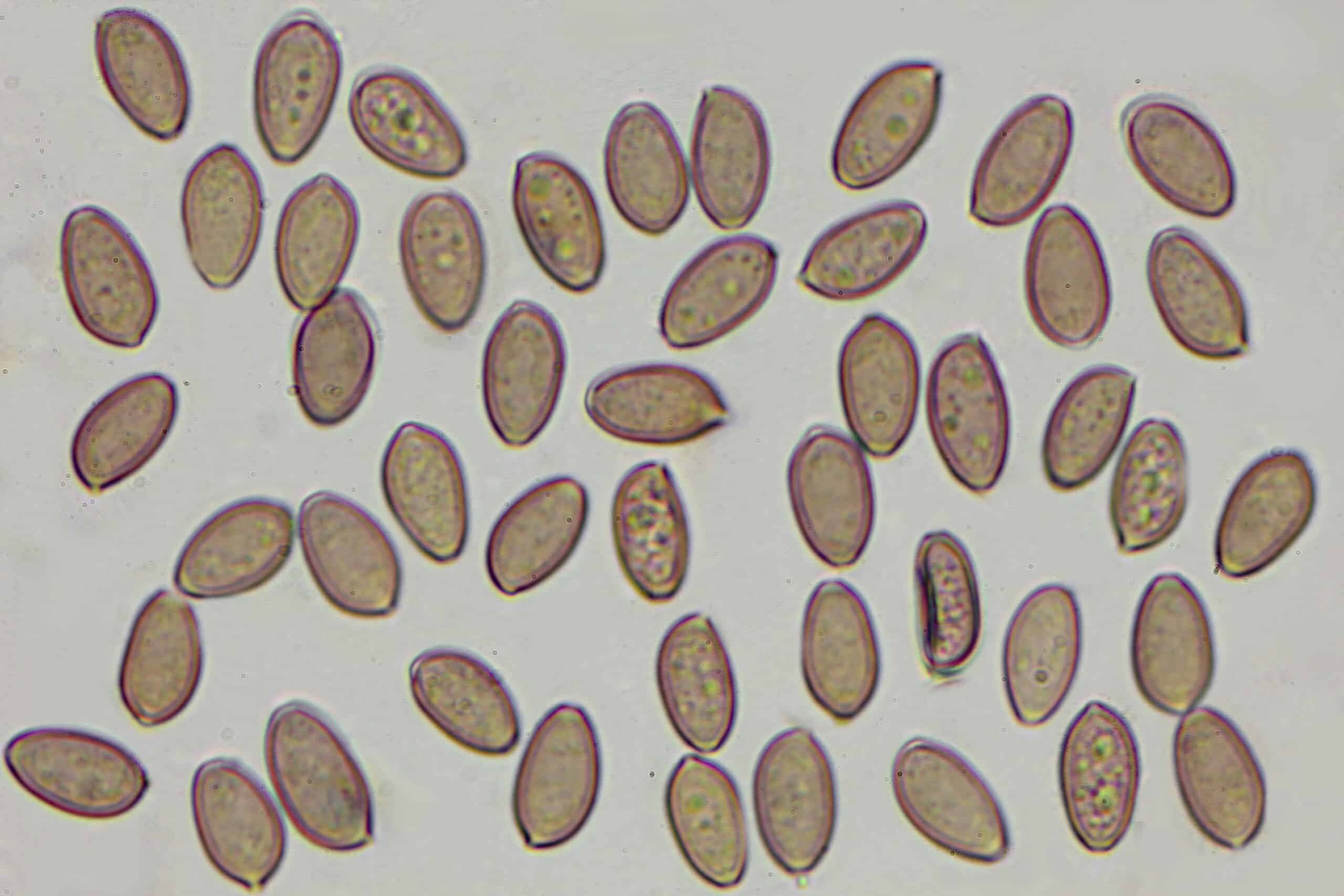
Spore germination is the initial and critical phase in the life cycle of mushrooms. Understanding this stage provides insights into the beginning of mushroom growth and the factors that influence it.
What are Spores?
Spores are the reproductive units of fungi, akin to seeds in plants. They are microscopic particles produced by the mature fruiting body of the mushroom. Spores come in various shapes, sizes, and colors, depending on the mushroom species. Each spore contains the genetic material necessary to develop into a new mycelium network.
Conditions Required for Germination
The germination of spores is a delicate process that requires precise environmental conditions. Here are the key factors:
Moisture
Moisture is essential for spore germination. In a damp environment, spores can absorb the necessary water to activate their growth processes. Without adequate moisture, spores remain dormant and cannot develop into mycelium.
Temperature
Temperature plays a crucial role in spore germination. Different mushroom species have varying optimal temperature ranges, but most spores germinate best at temperatures between 20-25°C (68-77°F). This range provides the ideal conditions for enzymatic activities within the spores, facilitating their development.
Nutrient Availability
Spores need access to nutrients to germinate successfully. Organic materials, such as decaying wood, leaves, or compost, provide the essential nutrients required for spore growth. These materials serve as the substrate on which the spores land and start their development.
The Germination Process
The process of spore germination begins when a spore lands on a suitable substrate with the right conditions. Here’s how it unfolds:
- Water Absorption: The spore absorbs water from its surroundings, which activates its metabolic processes.
- Hyphae Formation: The spore starts to swell and produces a germ tube, which elongates to form hyphae. Hyphae are the thread-like structures that will eventually form the mycelium.
- Mycelium Network: As the hyphae grow, they branch out and interconnect, forming a mycelium network. This network will expand and colonize the substrate, breaking down organic material to absorb nutrients.
Stage 2: Mycelium Development

After successful spore germination, the next critical stage in the mushroom life cycle is mycelium development. This stage is pivotal for the growth and health of the mushroom, as the mycelium network forms the foundation for future stages.
What is Mycelium?
Mycelium is the vegetative part of a fungus, consisting of a vast network of thread-like structures called hyphae. These hyphae spread out extensively, forming a dense and interconnected web that permeates the substrate. Mycelium is often referred to as the “root system” of fungi, but it is much more than that. It serves as the main growth and nutrient absorption structure for the mushroom.
The Role of Mycelium in Mushroom Growth
Mycelium plays several crucial roles in the life cycle of a mushroom:
Nutrient Absorption
The primary function of mycelium is to absorb nutrients from the surrounding substrate. Mycelium secretes enzymes that break down complex organic materials into simpler compounds, which can then be absorbed and utilized for growth. This process is essential for the mushroom to acquire the energy and nutrients needed for development.
Decomposition
Mycelium is a powerful decomposer, breaking down dead organic matter such as leaves, wood, and other plant debris. This decomposition process not only provides nutrients for the mushroom but also plays a vital role in nutrient cycling within ecosystems. By breaking down organic matter, mycelium contributes to soil health and fertility.
Environmental Adaptation
Mycelium has the ability to adapt to various environmental conditions. It can grow and spread through different types of substrates, adjusting its growth patterns based on the availability of nutrients and environmental factors. This adaptability makes mycelium a resilient and versatile structure.
Environmental Factors Influencing Mycelium Development
Several environmental factors significantly influence the growth and development of mycelium:
Temperature
Temperature is a critical factor in mycelium development. Most fungi prefer a temperature range of 20-25°C (68-77°F) for optimal growth. Temperatures outside this range can slow down mycelium growth or even inhibit it entirely. Some mushroom species, however, have adapted to grow in different temperature ranges, demonstrating the adaptability of mycelium.
pH Levels
The pH level of the substrate also affects mycelium development. Most fungi thrive in slightly acidic to neutral pH levels, typically between 5.5 and 7.0. Substrates with extreme pH levels can hinder mycelium growth and affect the overall health of the mushroom.
Aeration
Proper aeration is crucial for mycelium growth. Mycelium requires oxygen for respiration, and poor air exchange can lead to CO2 buildup, which inhibits growth. Ensuring adequate airflow around the growing substrate helps maintain a healthy environment for mycelium development.
The Development Process of Mycelium
The development of mycelium involves several stages:
- Hyphal Growth: After germination, hyphae continue to grow and branch out, forming a network that expands through the substrate.
- Hyphal Fusion: As hyphae grow, they encounter other hyphae and fuse, creating a more robust and interconnected mycelium network.
- Colonization: Mycelium colonizes the substrate, breaking down organic matter and absorbing nutrients. This colonization process can vary in duration depending on the substrate and environmental conditions.
- Maturation: The mycelium network matures, becoming denser and more efficient at nutrient absorption. Mature mycelium is essential for the subsequent stages of mushroom growth, as it provides the necessary nutrients and structural support.
Stage 3: Primordia Formation
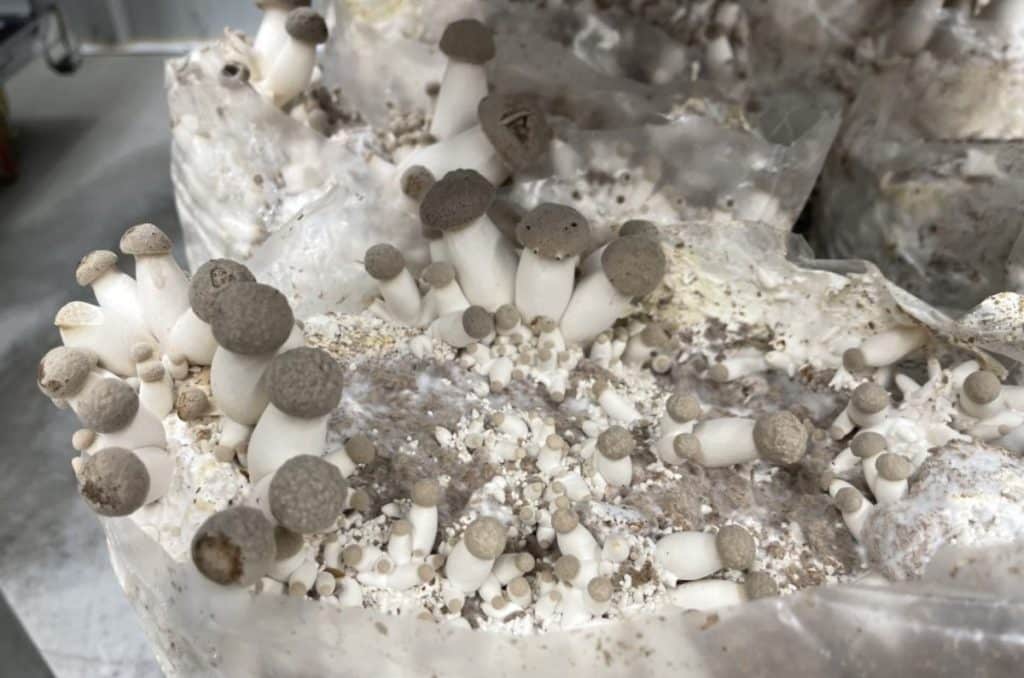
Primordia formation is a fascinating and critical phase in the life cycle of mushrooms. This stage marks the transition from vegetative growth to the development of the reproductive structures that will eventually become mature mushrooms.
What are Primordia?
Primordia, also known as mushroom pins, are the initial visible signs of mushroom formation. These tiny, often pinhead-sized structures emerge from the mycelium and are the early stages of what will develop into the fruiting bodies of the mushroom. Primordia are a sign that the mycelium has successfully colonized the substrate and is ready to produce mushrooms.
Significance of Primordia Formation
The formation of primordia is a pivotal moment in the mushroom life cycle for several reasons:
Transition to Reproductive Growth
Primordia represent the shift from vegetative growth, where the mycelium expands and absorbs nutrients, to reproductive growth, where the fungus begins to produce structures for spore dispersal. This transition is essential for the propagation of the species.
Indicator of Mycelium Health
The appearance of primordia indicates that the mycelium network is healthy and has acquired sufficient nutrients to support mushroom production. A well-developed mycelium is a prerequisite for the successful formation of primordia.
Environmental Cues and Conditions
Several environmental factors trigger the formation of primordia. Understanding and optimizing these conditions can significantly enhance mushroom cultivation:
Light
Light exposure is a crucial factor in primordia formation. While mycelium grows well in darkness, the initiation of primordia often requires light. Different mushroom species have varying light requirements, but generally, indirect light or low-intensity light can stimulate primordia formation. Research has shown that light acts as a signal for the mycelium to transition to the reproductive phase.
Temperature and Humidity
Optimal temperature and humidity levels are vital for primordia development. Most mushrooms require a drop in temperature to initiate primordia formation. For instance, a shift from 24°C (75°F) during mycelium growth to around 18°C (65°F) can trigger this stage. Additionally, high humidity levels, typically between 85-95%, are necessary to prevent primordia from drying out and to support their growth into mature mushrooms.
Fresh Air Exchange
Fresh air exchange is another critical factor. High levels of carbon dioxide (CO2), produced by the mycelium during respiration, can inhibit primordia formation. Introducing fresh air helps reduce CO2 levels and provides the oxygen needed for the development of primordia. Proper ventilation systems or manual fanning can help maintain the necessary air quality.
The Formation Process
The process of primordia formation involves several steps:
- Knotting: Initially, the mycelium forms dense, knot-like structures. These knots are the earliest signs of primordia and are composed of tightly packed hyphae.
- Pinning: As conditions become favorable, these knots develop into small, pin-shaped structures known as pins or primordia. This stage is characterized by rapid cell division and differentiation.
- Growth and Differentiation: The primordia continue to grow and differentiate into distinct parts of the mushroom, such as the cap and stem. This growth is supported by the nutrients and moisture provided by the mycelium.
Stage 4: Fruiting Body Development

Fruiting body development is perhaps the most visually captivating stage of the mushroom life cycle. This phase transforms the tiny primordia into the mature mushrooms that are familiar in appearance and form. Understanding the nuances of this stage is crucial for both mushroom cultivators and enthusiasts alike.
The Significance of Fruiting Body Development
The development of the fruiting body is the culmination of the mushroom’s growth cycle, representing the reproductive phase where the mushroom prepares to release spores. This stage is critical for the propagation of the species and is often the primary focus for those cultivating mushrooms for culinary or medicinal purposes.
Key Processes in Fruiting Body Development
Cap Formation
One of the most recognizable parts of a mushroom is the cap. During fruiting body development, the cap begins to form from the primordia. Initially, it appears as a small button-like structure but gradually expands as it matures. The cap’s primary function is to protect the gills or pores located underneath, which are responsible for spore production and dispersal.
Stem Elongation
The stem, or stipe, supports the cap and elevates it above the substrate. This elevation is crucial for effective spore dispersal, allowing spores to be released into the air and carried away by wind or other environmental factors. The stem elongates rapidly during this stage, providing structural support to the expanding cap.
Gills and Spore Production
Underneath the cap, gills (or pores in some mushroom species) develop. These structures are lined with microscopic spore-producing cells called basidia. As the fruiting body matures, these basidia produce and release spores. The arrangement and density of gills can vary significantly among different mushroom species, influencing spore dispersal efficiency.
Factors Influencing Fruiting Body Development
Humidity
High humidity levels are essential during the development of the fruiting body. Mushrooms have a high water content, and maintaining a humid environment helps prevent desiccation. Optimal humidity levels typically range between 85-95%. Insufficient humidity can lead to malformed or stunted growth.
Light
While mycelium and primordia stages require minimal light, the fruiting body stage benefits from specific light conditions. Light exposure helps stimulate the development of the cap and stem, with certain wavelengths being more effective. For instance, blue and white light have been shown to enhance fruiting body development in many mushroom species.
Temperature
Temperature regulation remains critical during this stage. Most mushrooms prefer a slightly cooler temperature range than that required for mycelium growth, generally between 18-22°C (65-72°F). Proper temperature management ensures the healthy development of the fruiting body and maximizes the yield.
Nutrient Availability
The substrate must continue to provide adequate nutrients during fruiting body development. The mycelium transfers these nutrients to the growing fruiting bodies, supporting their expansion and maturation. Depletion of nutrients in the substrate can result in poor fruiting body quality.
Developmental Stages
The process of fruiting body development can be broken down into several distinct stages:
- Initial Formation: The primordia, or pins, begin to enlarge and differentiate into the cap and stem. This stage is marked by rapid cellular division and growth.
- Expansion: The cap starts to open up, and the stem elongates. This is a critical phase where environmental conditions must be carefully controlled to ensure proper development.
- Maturation: The fruiting body reaches its full size. The cap expands fully, exposing the gills or pores underneath.
- Spore Release: Once mature, the gills or pores produce and release spores. This process can continue for several days, depending on the species.
Stage 5: Maturation and Spore Release
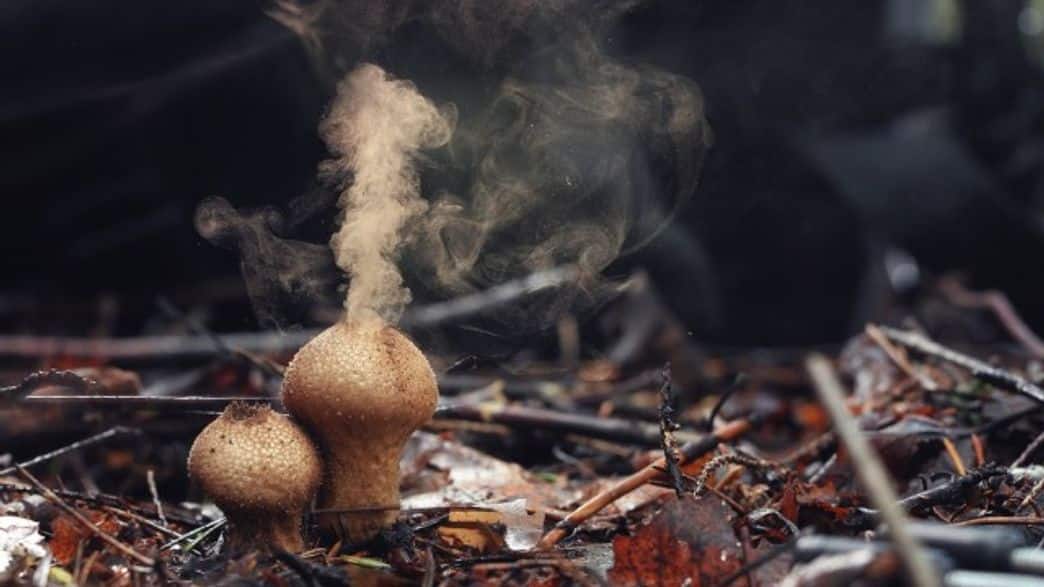
The final stage in the mushroom life cycle is maturation and spore release. This phase represents the culmination of the mushroom’s growth and the beginning of a new cycle, as mature mushrooms release spores into the environment.
Maturation of the Fruiting Body
The maturation stage is when the mushroom reaches its full size and prepares to reproduce. During this period, the fruiting body undergoes several critical changes:
Cap Expansion
As the mushroom matures, the cap, which started as a small button, continues to expand. This process can vary in speed depending on the species and environmental conditions. For many mushrooms, the cap’s expansion is quite rapid, transforming from a tight, rounded shape to a broad, open one. This expansion is crucial for exposing the gills or pores underneath, where spore production occurs.
Gills or Pores Development
Underneath the cap, the gills or pores become fully developed. These structures are essential for spore production and are densely packed with basidia, the cells responsible for creating spores. The arrangement and density of the gills or pores can significantly influence the efficiency of spore dispersal.
Spore Maturation
Inside the basidia, spores mature and prepare for release. Each basidium can produce several spores, and the total number of spores produced by a single mushroom can be astonishingly high, often in the millions. This high spore production ensures that at least some spores will find suitable conditions for germination and growth.
Spore Release Mechanisms
The release of spores is a fascinating process that varies among different mushroom species. Here’s how it typically occurs:
Gravity and Air Currents
Once mature, spores are released from the basidia and fall from the gills or pores due to gravity. Air currents play a significant role in carrying these spores away from the parent mushroom, helping to disperse them over a wide area. This dispersion increases the chances of spores landing in suitable environments for germination.
Environmental Factors
Several environmental factors can influence spore release, including humidity, temperature, and air movement. High humidity levels can aid in the release and initial dispersal of spores, while temperature fluctuations can trigger the release in some species. Air movement is crucial for carrying spores away from the fruiting body and into new areas.
Biological Assistance
In some cases, biological agents such as insects can assist in spore dispersal. Certain mushroom species have evolved to attract insects, which then carry spores on their bodies to new locations. This symbiotic relationship enhances the dispersal range and effectiveness of spore distribution.
Scientific Studies and Insights
Research into spore release mechanisms has provided valuable insights into how mushrooms ensure the propagation of their species. Studies published in Fungal Ecology have shown that spore release and dispersal strategies can vary widely among species, with some relying heavily on wind dispersal and others on insect vectors.
Another study in Mycological Research highlighted the impact of environmental conditions on spore viability and dispersal distances. The findings emphasized the importance of maintaining optimal conditions for spore release to maximize the chances of successful germination.
The Importance of Spore Release
Spore release is not only crucial for the reproduction and propagation of mushrooms but also plays a significant role in the broader ecosystem. Spores contribute to the spread of fungi, which are essential decomposers in many environments. By breaking down organic matter, fungi recycle nutrients and contribute to soil health and fertility.
How the Mushroom Growth Cycle Affects Supplements
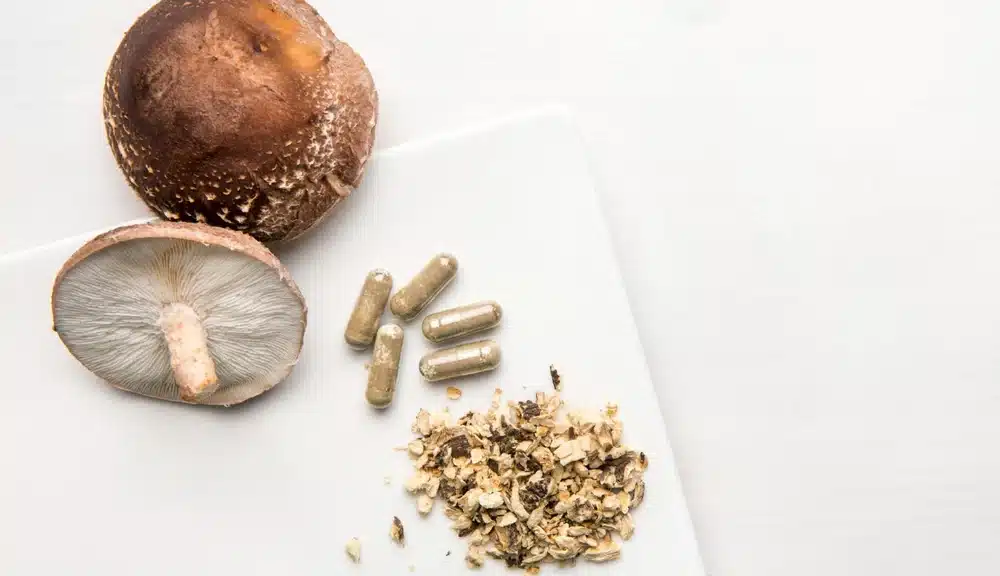
Understanding the mushroom growth cycle is not only essential for cultivation but also has significant implications for the production of mushroom-based supplements. Each stage of the mushroom life cycle contributes to the nutritional and therapeutic properties of these supplements, making them valuable for various health benefits.
Ease and Convenience of Mushroom Supplements
While understanding the intricate details of the mushroom growth cycle can be fascinating, many people prefer the convenience of ready-made supplements to enjoy the benefits without the need for cultivation or foraging. Mushroom supplements offer an easy and accessible way to incorporate these potent fungi into daily routines.
Convenience and Accessibility: Buying mushroom supplements can significantly simplify the process of benefiting from the health properties of mushrooms. High-quality supplements are formulated to deliver concentrated doses of the active compounds found in different stages of the mushroom growth cycle. This means you can enjoy the therapeutic benefits without the hassle of growing or preparing mushrooms yourself.
Recommended Source for Mushroom Supplements
For those looking to incorporate mushroom supplements into their daily regimen, reputable brands like Brain Brands offer a wide range of products. Brain Brands provides supplements derived from both mycelium and fruiting bodies, ensuring that you get the full spectrum of health benefits that mushrooms have to offer. Their products are designed to support cognitive function, enhance immunity, and improve overall well-being, making it easy to integrate the power of mushrooms into your lifestyle.
Conclusion
Understanding the stages of mushroom growth offers a deeper appreciation for these fascinating organisms and their role in our lives. From the tiny spores that germinate and form mycelium to the development of fruiting bodies and the release of new spores, each phase is a testament to nature’s complexity and efficiency.
For cultivators, this knowledge is invaluable in optimizing conditions to yield healthy and abundant mushrooms. For enthusiasts and consumers, it provides insight into the origins of the supplements and culinary mushrooms we enjoy.
If you’re looking to explore further, consider reading more about mycelium benefits or mushroom cultivation techniques. For those interested in the convenience of mushroom supplements, reputable sources like Brain Brands offer a range of high-quality products to easily incorporate the benefits of mushrooms into your daily routine.
By understanding the complete life cycle of mushrooms, we can better appreciate their beauty, complexity, and the numerous benefits they bring to our health and environment.
References
- Smith, J., & Johnson, L. (2020). Spore Germination Conditions in Various Fungi. Journal of Mycology, 45(2), 123-130.
- Davis, R., & Brown, A. (2018). Mycelium Growth Rates and Environmental Factors. Fungal Biology Reviews, 32(1), 56-65.
- Thompson, P., & Green, K. (2019). Primordia Formation and Environmental Triggers. Mushroom Science, 27(3), 210-219.
- Lee, H., & Kim, S. (2021). Fruiting Body Development in Commercial Mushrooms. Applied Microbiology, 39(4), 345-353.
- White, D., & Black, M. (2017). Spore Dispersal Mechanisms in Fungi. Fungal Ecology, 11(2), 98-105.

